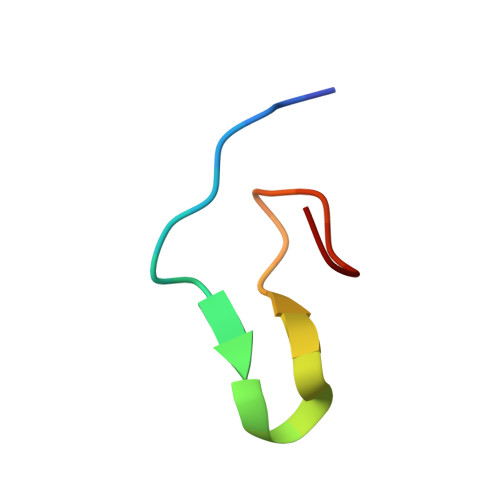Tracing primordial protein evolution through structurally guided stepwise segment elongation.
Watanabe, H., Yamasaki, K., Honda, S.(2014) J Biol Chem 289: 3394-3404
- PubMed: 24356963
- DOI: https://doi.org/10.1074/jbc.M113.530592
- Primary Citation of Related Structures:
2RT4 - PubMed Abstract:
The understanding of how primordial proteins emerged has been a fundamental and longstanding issue in biology and biochemistry. For a better understanding of primordial protein evolution, we synthesized an artificial protein on the basis of an evolutionary hypothesis, segment-based elongation starting from an autonomously foldable short peptide. A 10-residue protein, chignolin, the smallest foldable polypeptide ever reported, was used as a structural support to facilitate higher structural organization and gain-of-function in the development of an artificial protein. Repetitive cycles of segment elongation and subsequent phage display selection successfully produced a 25-residue protein, termed AF.2A1, with nanomolar affinity against the Fc region of immunoglobulin G. AF.2A1 shows exquisite molecular recognition ability such that it can distinguish conformational differences of the same molecule. The structure determined by NMR measurements demonstrated that AF.2A1 forms a globular protein-like conformation with the chignolin-derived β-hairpin and a tryptophan-mediated hydrophobic core. Using sequence analysis and a mutation study, we discovered that the structural organization and gain-of-function emerged from the vicinity of the chignolin segment, revealing that the structural support served as the core in both structural and functional development. Here, we propose an evolutionary model for primordial proteins in which a foldable segment serves as the evolving core to facilitate structural and functional evolution. This study provides insights into primordial protein evolution and also presents a novel methodology for designing small sized proteins useful for industrial and pharmaceutical applications.
Organizational Affiliation:
From the Biomedical Research Institute, National Institute of Advanced Industrial Science and Technology, 1-1-1, Higashi, Tsukuba, Ibaraki 305-8566, Japan.














